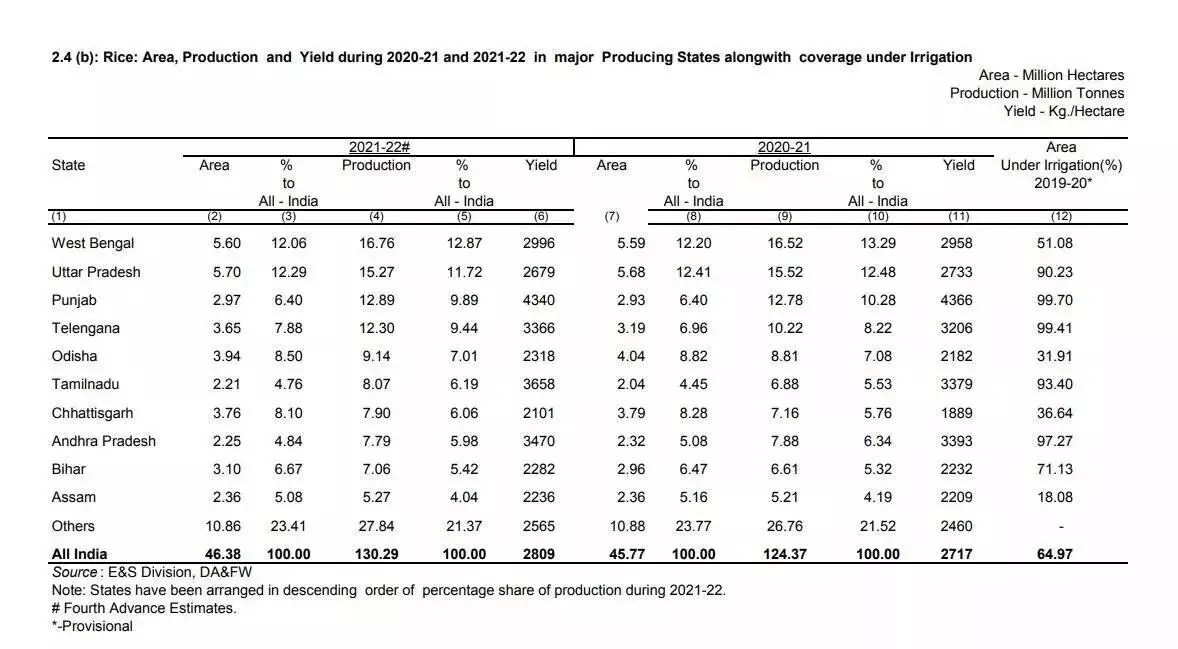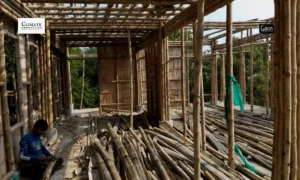In response to a question posed in the ongoing Monsoon Session of the Parliament, Union Minister of Earth Sciences in Lok Sabha Kiren Rijiju stated on July 26 that five states — Uttar Pradesh, Bihar, West Bengal, Meghalaya and Nagaland have shown significant decreasing trends in southwest monsoon rainfall during a 30-years period (1989-2018).
“The annual rainfall over these five states along with the states of Arunachal Pradesh and Himachal Pradesh also show significant decreasing trends,” the minister said.
Statewise, as per the Union Ministry of Agriculture’s Fourth Revised Estimate on rice production in 2021-22, West Bengal contributed the lion’s share of rice production in the country with a contribution percentage of 12.87 followed by Uttar Pradesh at 11.72 per cent.
As per the Union Ministry of Agriculture and Farmers’ Welfare, more than half of the farmers in the country depend entirely on rainfed agriculture. The erratic changes in the rainfall patterns adversely affect the farmers in India who depend on the timely arrival and withdrawal of rainfall for sowing, irrigating and harvesting their crops.
Paddy farmers unable to avail rice for their families
As reported by Gaon Connection yesterday, on July 31, in rural Bihar, Nitish Kumar Yadav who owns 16 bighas of land is a living example of the adverse consequences of the data presented by Rijiju .
Leave alone profits, he won’t even have rice to eat this summer as it has barely rained this year in Bihar.
Irrigating their fields has now become a herculean task and farmers are helplessly watching the paddy saplings dry and wilt in the heat. The state is possibly heading towards a drought this year.

Meanwhile, Rijiju told Lok Sabha that associated with the climate change ‘due to global warming, temporal and spatial diversity in severe weathers including extremely heavy rainfall have been observed in the country’.
“The recent IPCC [Intergovernmental Panel on Climate Change] climate change report indicates that these trends will continue in future and those are not preventable,” the minister added.
‘Excess rainfall events on the rise’
In the Upper House, Rijiju responded to another monsoon-related question on July 20 and stated that “it can be noticed that in recent years, the number of heavy rainfall events have increased especially in the month of October, mainly due to delayed withdrawal of southwest monsoon.”
The data presented by Rijiju mentioned that October witnessed 607 heavy rainfall, 129 very heavy rainfall and 10 extremely heavy rainfall events, in 2017. However, in 2022, the post-monsoon month saw 786 heavy rainfall, 133 very heavy rainfall and 13 extremely heavy rainfall events.
The events of heavy rainfall in monsoon season (June, July, August, September) have increased from 5,833 in 2018 to 7,251 in 2022 — a 24 per cent rise; very heavy rainfall events in monsoon season have increased from 1,642 in 2018 to 1,874 in 2022 — a 14 per cent rise; and extremely heavy rainfall events in monsoon season have risen from 288 in 2018 to 296 in 2022.
Also Read: The man who owns 435,000 sq ft of land may not have rice to eat this year
According to the data provided by the ministry, the pre-monsoon month of May reported 505 heavy rainfall events and 91 events of very heavy rainfall in 2022, as compared to 195 and 12 such events in 2017. Such events in May had dipped in 2019 but again saw a rise henceforth.
As per the India Meterological Department [IMD], moderate rainfall is 15.6 to 64.4 mm [millimetres]; heavy rainfall is 64.5 to 115.5 mm; very heavy rainfall is 115.6 to 204.4 mm. The rainfall of more than 204.5 mm is recorded as an event of extremely high rainfall.
Based on an earlier report by Gaon Connection on January 11, cumin farmers in Rajasthan were switching to growing mustard because the climate-sensitive jeera could not bear with the erratic climate change, unpredictable rainfall and hail storms — events hardly heard of in the past for Rajasthan.
Meanwhile, in yet another report published in Gaon Connection on July 18, farmers’ groups in Maharashtra demanded declaration of drought in the state.
While several states in north India have been reeling under massive floods, in peninsular India, farmers are staring at drought conditions due to deficient monsoon rainfall.




















